Hilton Hospitality Operations (TP): Food Production and Menu Analysis
VerifiedAdded on 2023/06/15
|11
|3153
|217
Report
AI Summary
This report provides a detailed analysis of hospitality operations, with a focus on food production systems and menu planning considerations within the context of Hilton hotels. It begins by examining different types of food production systems, including conventional, commissary, ready-prepared, and assembly-serve, highlighting their advantages and disadvantages for a large hotel chain. The report then explores various food and beverage service methods such as table service, English service, buffet service, French service and cafeteria service, discussing their suitability for different dining experiences. Furthermore, it analyses key considerations and constraints in menu planning, such as dish selection, preparation time, menu type, service methods, skilled staff availability, quality control, and resource availability. Finally, the report critically examines sustainable menu planning considerations, emphasizing the importance of seasonal fruits, organic foods, and sustainable seafood to attract environmentally conscious customers. Desklib offers a platform to explore similar solved assignments and study resources for students.
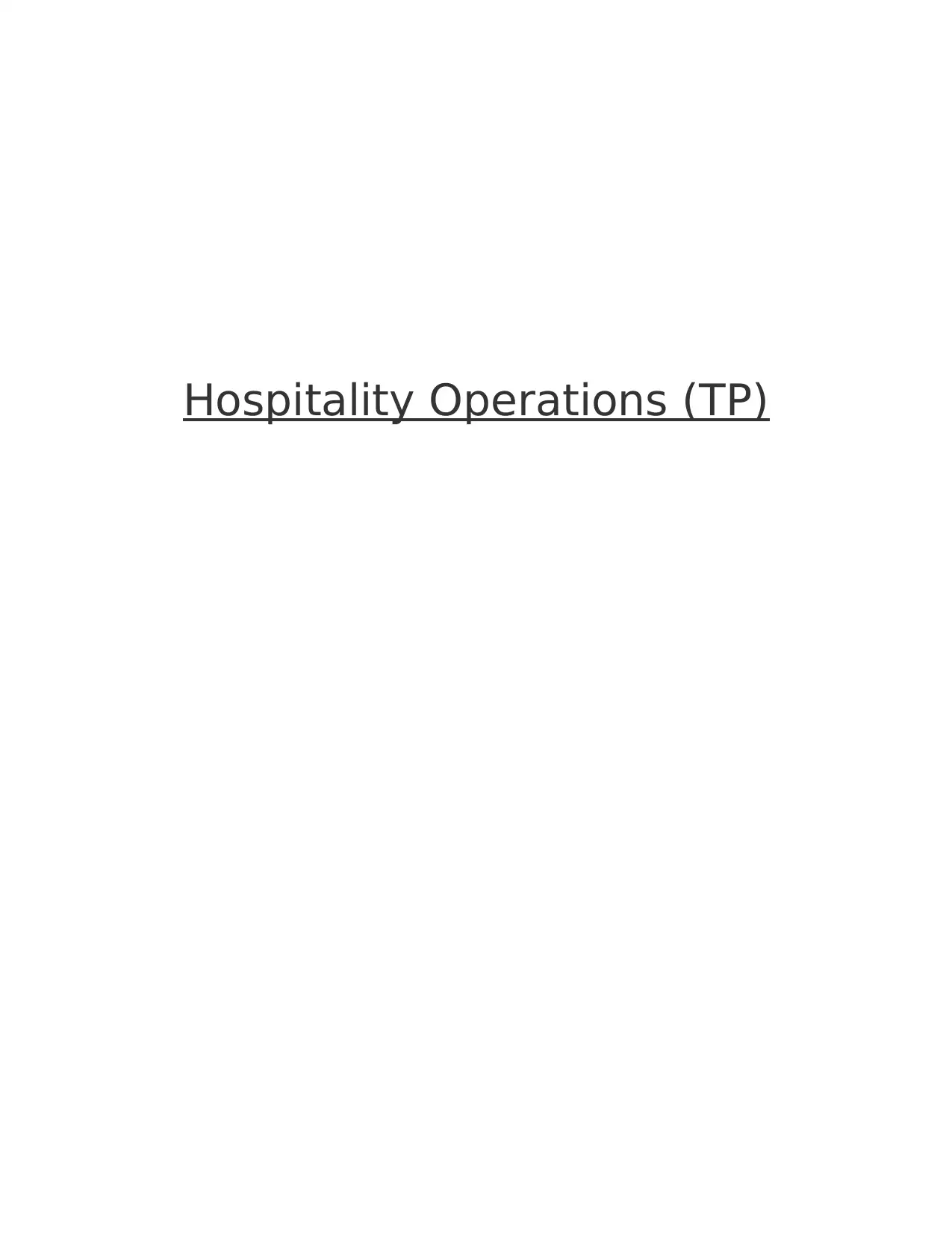
Hospitality Operations (TP)
Paraphrase This Document
Need a fresh take? Get an instant paraphrase of this document with our AI Paraphraser
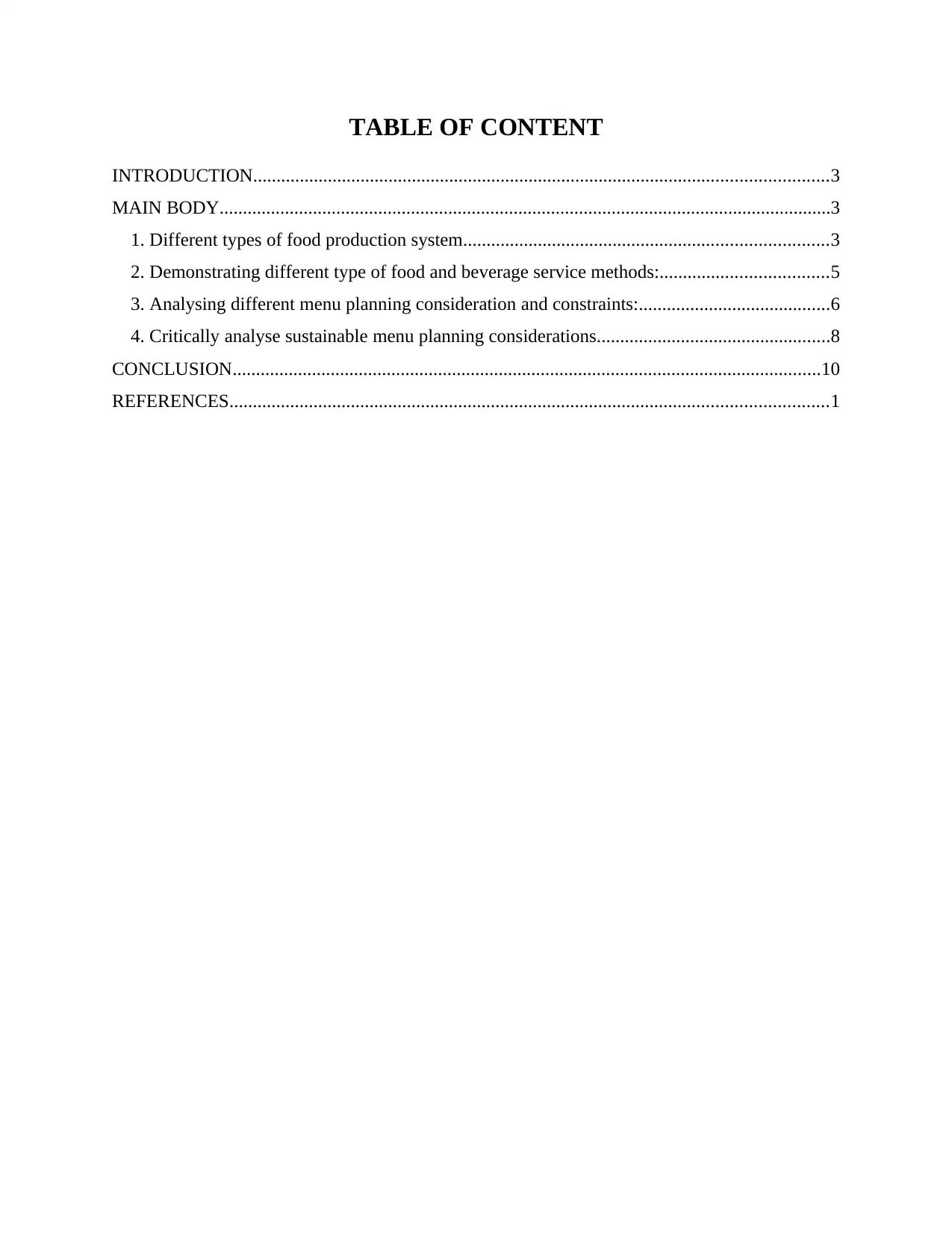
TABLE OF CONTENT
INTRODUCTION...........................................................................................................................3
MAIN BODY...................................................................................................................................3
1. Different types of food production system..............................................................................3
2. Demonstrating different type of food and beverage service methods:....................................5
3. Analysing different menu planning consideration and constraints:.........................................6
4. Critically analyse sustainable menu planning considerations..................................................8
CONCLUSION..............................................................................................................................10
REFERENCES................................................................................................................................1
INTRODUCTION...........................................................................................................................3
MAIN BODY...................................................................................................................................3
1. Different types of food production system..............................................................................3
2. Demonstrating different type of food and beverage service methods:....................................5
3. Analysing different menu planning consideration and constraints:.........................................6
4. Critically analyse sustainable menu planning considerations..................................................8
CONCLUSION..............................................................................................................................10
REFERENCES................................................................................................................................1
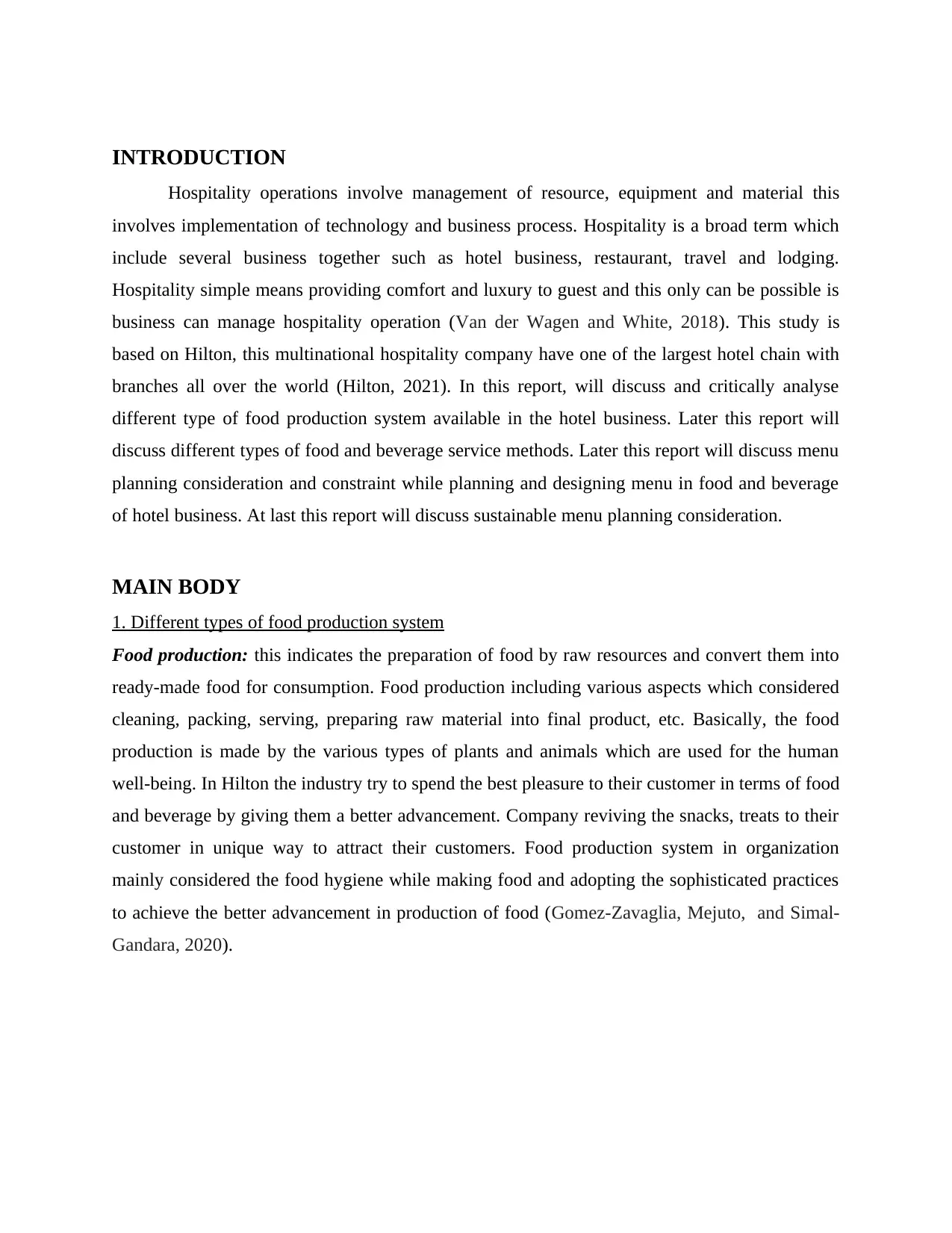
INTRODUCTION
Hospitality operations involve management of resource, equipment and material this
involves implementation of technology and business process. Hospitality is a broad term which
include several business together such as hotel business, restaurant, travel and lodging.
Hospitality simple means providing comfort and luxury to guest and this only can be possible is
business can manage hospitality operation (Van der Wagen and White, 2018). This study is
based on Hilton, this multinational hospitality company have one of the largest hotel chain with
branches all over the world (Hilton, 2021). In this report, will discuss and critically analyse
different type of food production system available in the hotel business. Later this report will
discuss different types of food and beverage service methods. Later this report will discuss menu
planning consideration and constraint while planning and designing menu in food and beverage
of hotel business. At last this report will discuss sustainable menu planning consideration.
MAIN BODY
1. Different types of food production system
Food production: this indicates the preparation of food by raw resources and convert them into
ready-made food for consumption. Food production including various aspects which considered
cleaning, packing, serving, preparing raw material into final product, etc. Basically, the food
production is made by the various types of plants and animals which are used for the human
well-being. In Hilton the industry try to spend the best pleasure to their customer in terms of food
and beverage by giving them a better advancement. Company reviving the snacks, treats to their
customer in unique way to attract their customers. Food production system in organization
mainly considered the food hygiene while making food and adopting the sophisticated practices
to achieve the better advancement in production of food (Gomez-Zavaglia, Mejuto, and Simal-
Gandara, 2020).
Hospitality operations involve management of resource, equipment and material this
involves implementation of technology and business process. Hospitality is a broad term which
include several business together such as hotel business, restaurant, travel and lodging.
Hospitality simple means providing comfort and luxury to guest and this only can be possible is
business can manage hospitality operation (Van der Wagen and White, 2018). This study is
based on Hilton, this multinational hospitality company have one of the largest hotel chain with
branches all over the world (Hilton, 2021). In this report, will discuss and critically analyse
different type of food production system available in the hotel business. Later this report will
discuss different types of food and beverage service methods. Later this report will discuss menu
planning consideration and constraint while planning and designing menu in food and beverage
of hotel business. At last this report will discuss sustainable menu planning consideration.
MAIN BODY
1. Different types of food production system
Food production: this indicates the preparation of food by raw resources and convert them into
ready-made food for consumption. Food production including various aspects which considered
cleaning, packing, serving, preparing raw material into final product, etc. Basically, the food
production is made by the various types of plants and animals which are used for the human
well-being. In Hilton the industry try to spend the best pleasure to their customer in terms of food
and beverage by giving them a better advancement. Company reviving the snacks, treats to their
customer in unique way to attract their customers. Food production system in organization
mainly considered the food hygiene while making food and adopting the sophisticated practices
to achieve the better advancement in production of food (Gomez-Zavaglia, Mejuto, and Simal-
Gandara, 2020).
⊘ This is a preview!⊘
Do you want full access?
Subscribe today to unlock all pages.

Trusted by 1+ million students worldwide
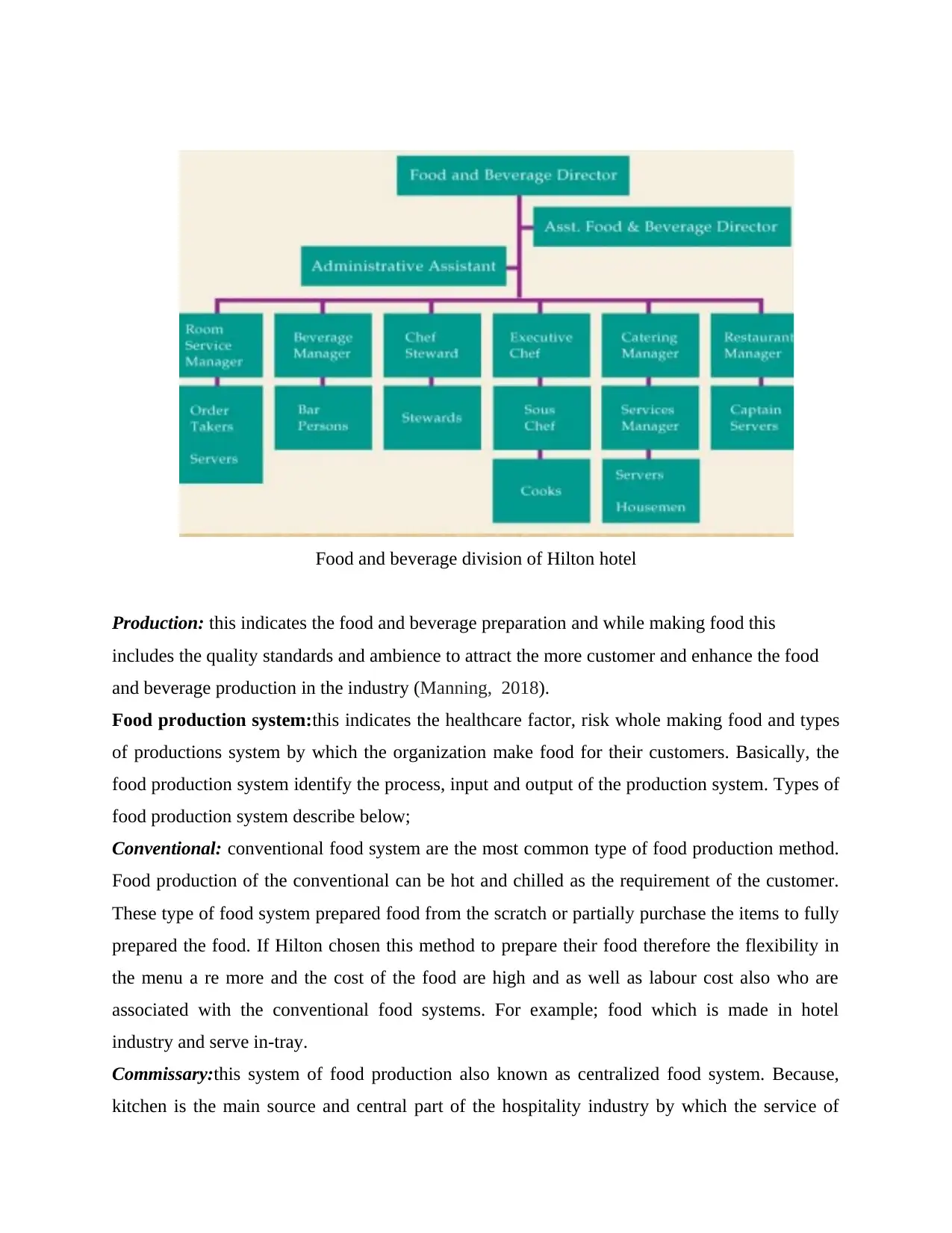
Food and beverage division of Hilton hotel
Production: this indicates the food and beverage preparation and while making food this
includes the quality standards and ambience to attract the more customer and enhance the food
and beverage production in the industry (Manning, 2018).
Food production system:this indicates the healthcare factor, risk whole making food and types
of productions system by which the organization make food for their customers. Basically, the
food production system identify the process, input and output of the production system. Types of
food production system describe below;
Conventional: conventional food system are the most common type of food production method.
Food production of the conventional can be hot and chilled as the requirement of the customer.
These type of food system prepared food from the scratch or partially purchase the items to fully
prepared the food. If Hilton chosen this method to prepare their food therefore the flexibility in
the menu a re more and the cost of the food are high and as well as labour cost also who are
associated with the conventional food systems. For example; food which is made in hotel
industry and serve in-tray.
Commissary:this system of food production also known as centralized food system. Because,
kitchen is the main source and central part of the hospitality industry by which the service of
Production: this indicates the food and beverage preparation and while making food this
includes the quality standards and ambience to attract the more customer and enhance the food
and beverage production in the industry (Manning, 2018).
Food production system:this indicates the healthcare factor, risk whole making food and types
of productions system by which the organization make food for their customers. Basically, the
food production system identify the process, input and output of the production system. Types of
food production system describe below;
Conventional: conventional food system are the most common type of food production method.
Food production of the conventional can be hot and chilled as the requirement of the customer.
These type of food system prepared food from the scratch or partially purchase the items to fully
prepared the food. If Hilton chosen this method to prepare their food therefore the flexibility in
the menu a re more and the cost of the food are high and as well as labour cost also who are
associated with the conventional food systems. For example; food which is made in hotel
industry and serve in-tray.
Commissary:this system of food production also known as centralized food system. Because,
kitchen is the main source and central part of the hospitality industry by which the service of
Paraphrase This Document
Need a fresh take? Get an instant paraphrase of this document with our AI Paraphraser
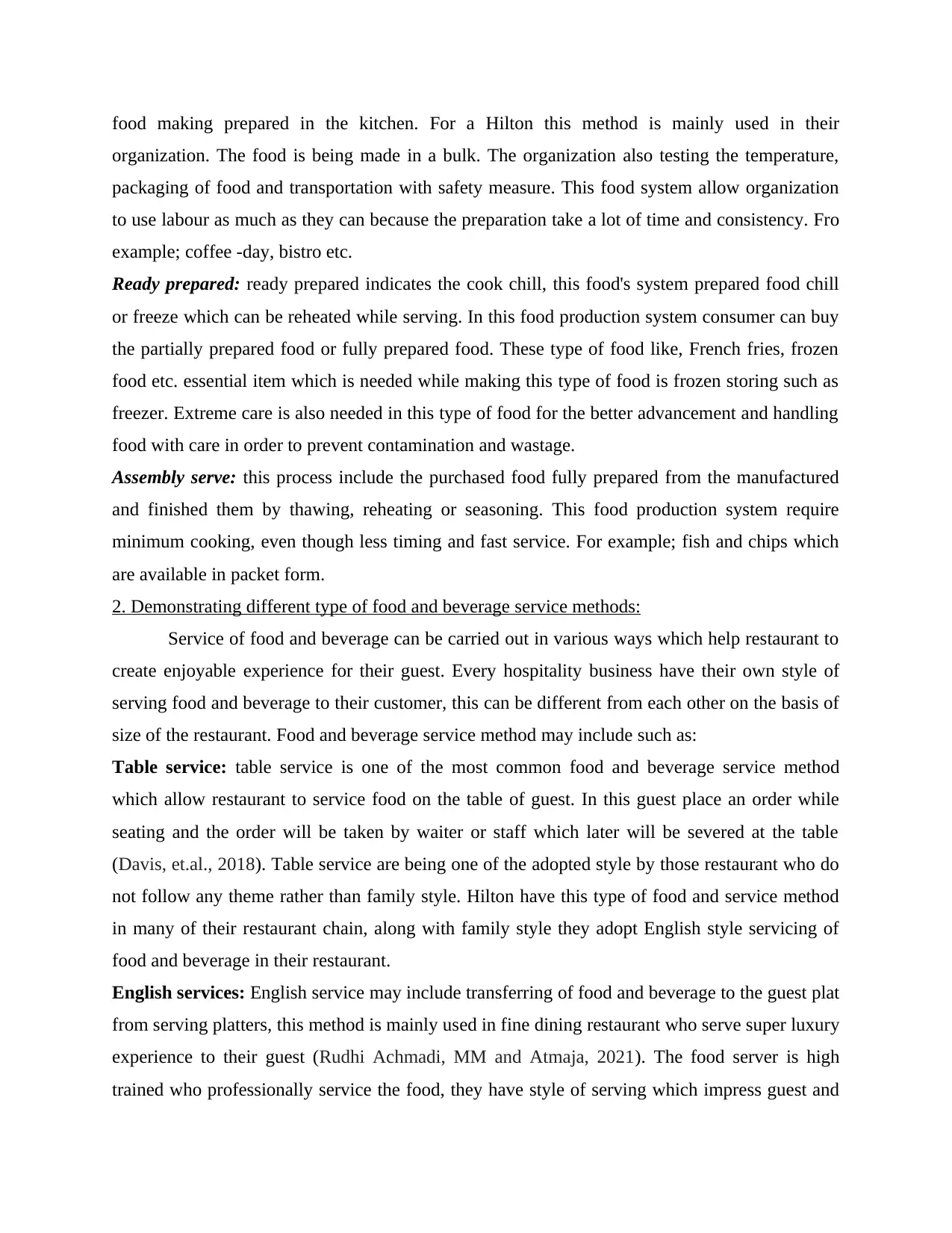
food making prepared in the kitchen. For a Hilton this method is mainly used in their
organization. The food is being made in a bulk. The organization also testing the temperature,
packaging of food and transportation with safety measure. This food system allow organization
to use labour as much as they can because the preparation take a lot of time and consistency. Fro
example; coffee -day, bistro etc.
Ready prepared: ready prepared indicates the cook chill, this food's system prepared food chill
or freeze which can be reheated while serving. In this food production system consumer can buy
the partially prepared food or fully prepared food. These type of food like, French fries, frozen
food etc. essential item which is needed while making this type of food is frozen storing such as
freezer. Extreme care is also needed in this type of food for the better advancement and handling
food with care in order to prevent contamination and wastage.
Assembly serve: this process include the purchased food fully prepared from the manufactured
and finished them by thawing, reheating or seasoning. This food production system require
minimum cooking, even though less timing and fast service. For example; fish and chips which
are available in packet form.
2. Demonstrating different type of food and beverage service methods:
Service of food and beverage can be carried out in various ways which help restaurant to
create enjoyable experience for their guest. Every hospitality business have their own style of
serving food and beverage to their customer, this can be different from each other on the basis of
size of the restaurant. Food and beverage service method may include such as:
Table service: table service is one of the most common food and beverage service method
which allow restaurant to service food on the table of guest. In this guest place an order while
seating and the order will be taken by waiter or staff which later will be severed at the table
(Davis, et.al., 2018). Table service are being one of the adopted style by those restaurant who do
not follow any theme rather than family style. Hilton have this type of food and service method
in many of their restaurant chain, along with family style they adopt English style servicing of
food and beverage in their restaurant.
English services: English service may include transferring of food and beverage to the guest plat
from serving platters, this method is mainly used in fine dining restaurant who serve super luxury
experience to their guest (Rudhi Achmadi, MM and Atmaja, 2021). The food server is high
trained who professionally service the food, they have style of serving which impress guest and
organization. The food is being made in a bulk. The organization also testing the temperature,
packaging of food and transportation with safety measure. This food system allow organization
to use labour as much as they can because the preparation take a lot of time and consistency. Fro
example; coffee -day, bistro etc.
Ready prepared: ready prepared indicates the cook chill, this food's system prepared food chill
or freeze which can be reheated while serving. In this food production system consumer can buy
the partially prepared food or fully prepared food. These type of food like, French fries, frozen
food etc. essential item which is needed while making this type of food is frozen storing such as
freezer. Extreme care is also needed in this type of food for the better advancement and handling
food with care in order to prevent contamination and wastage.
Assembly serve: this process include the purchased food fully prepared from the manufactured
and finished them by thawing, reheating or seasoning. This food production system require
minimum cooking, even though less timing and fast service. For example; fish and chips which
are available in packet form.
2. Demonstrating different type of food and beverage service methods:
Service of food and beverage can be carried out in various ways which help restaurant to
create enjoyable experience for their guest. Every hospitality business have their own style of
serving food and beverage to their customer, this can be different from each other on the basis of
size of the restaurant. Food and beverage service method may include such as:
Table service: table service is one of the most common food and beverage service method
which allow restaurant to service food on the table of guest. In this guest place an order while
seating and the order will be taken by waiter or staff which later will be severed at the table
(Davis, et.al., 2018). Table service are being one of the adopted style by those restaurant who do
not follow any theme rather than family style. Hilton have this type of food and service method
in many of their restaurant chain, along with family style they adopt English style servicing of
food and beverage in their restaurant.
English services: English service may include transferring of food and beverage to the guest plat
from serving platters, this method is mainly used in fine dining restaurant who serve super luxury
experience to their guest (Rudhi Achmadi, MM and Atmaja, 2021). The food server is high
trained who professionally service the food, they have style of serving which impress guest and
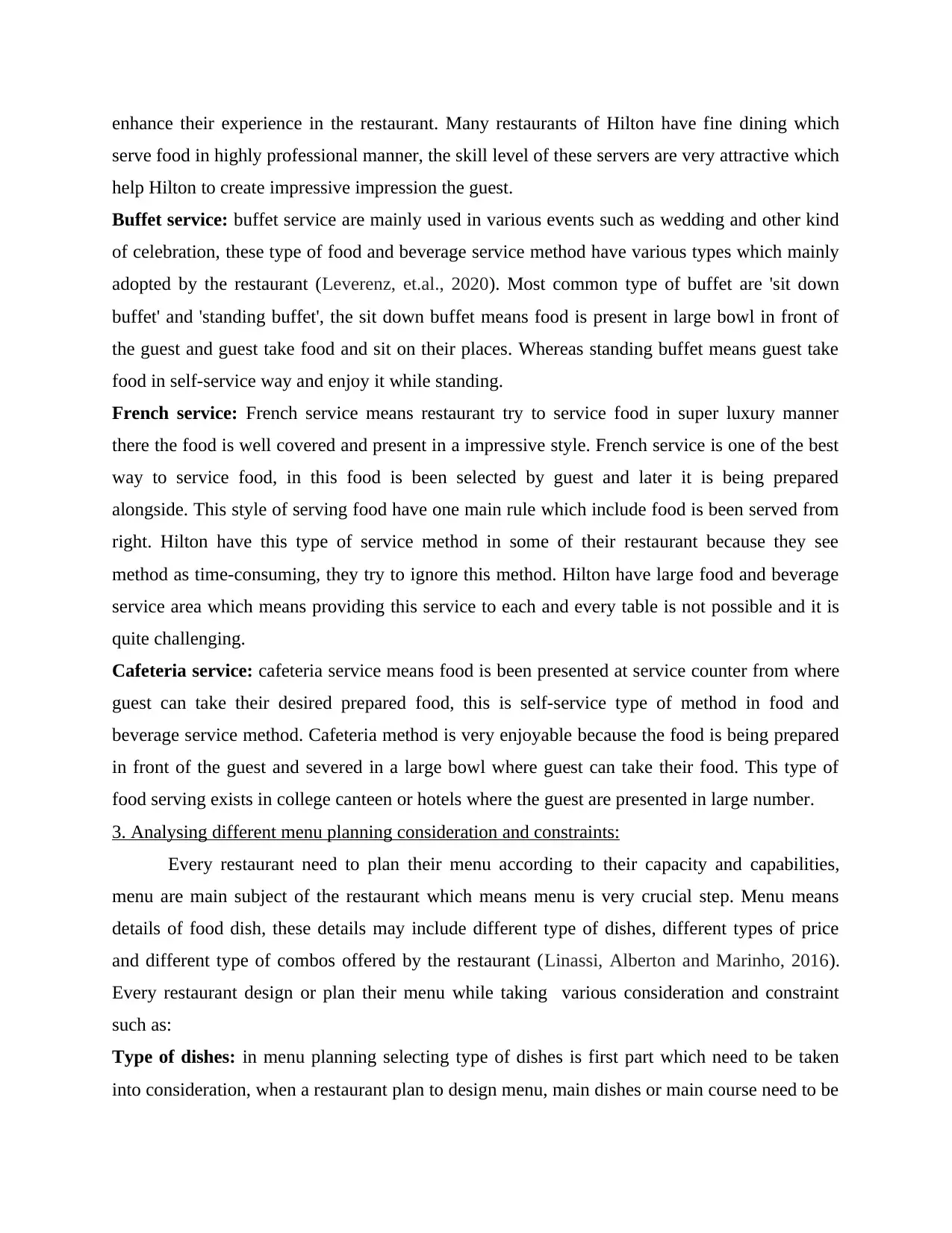
enhance their experience in the restaurant. Many restaurants of Hilton have fine dining which
serve food in highly professional manner, the skill level of these servers are very attractive which
help Hilton to create impressive impression the guest.
Buffet service: buffet service are mainly used in various events such as wedding and other kind
of celebration, these type of food and beverage service method have various types which mainly
adopted by the restaurant (Leverenz, et.al., 2020). Most common type of buffet are 'sit down
buffet' and 'standing buffet', the sit down buffet means food is present in large bowl in front of
the guest and guest take food and sit on their places. Whereas standing buffet means guest take
food in self-service way and enjoy it while standing.
French service: French service means restaurant try to service food in super luxury manner
there the food is well covered and present in a impressive style. French service is one of the best
way to service food, in this food is been selected by guest and later it is being prepared
alongside. This style of serving food have one main rule which include food is been served from
right. Hilton have this type of service method in some of their restaurant because they see
method as time-consuming, they try to ignore this method. Hilton have large food and beverage
service area which means providing this service to each and every table is not possible and it is
quite challenging.
Cafeteria service: cafeteria service means food is been presented at service counter from where
guest can take their desired prepared food, this is self-service type of method in food and
beverage service method. Cafeteria method is very enjoyable because the food is being prepared
in front of the guest and severed in a large bowl where guest can take their food. This type of
food serving exists in college canteen or hotels where the guest are presented in large number.
3. Analysing different menu planning consideration and constraints:
Every restaurant need to plan their menu according to their capacity and capabilities,
menu are main subject of the restaurant which means menu is very crucial step. Menu means
details of food dish, these details may include different type of dishes, different types of price
and different type of combos offered by the restaurant (Linassi, Alberton and Marinho, 2016).
Every restaurant design or plan their menu while taking various consideration and constraint
such as:
Type of dishes: in menu planning selecting type of dishes is first part which need to be taken
into consideration, when a restaurant plan to design menu, main dishes or main course need to be
serve food in highly professional manner, the skill level of these servers are very attractive which
help Hilton to create impressive impression the guest.
Buffet service: buffet service are mainly used in various events such as wedding and other kind
of celebration, these type of food and beverage service method have various types which mainly
adopted by the restaurant (Leverenz, et.al., 2020). Most common type of buffet are 'sit down
buffet' and 'standing buffet', the sit down buffet means food is present in large bowl in front of
the guest and guest take food and sit on their places. Whereas standing buffet means guest take
food in self-service way and enjoy it while standing.
French service: French service means restaurant try to service food in super luxury manner
there the food is well covered and present in a impressive style. French service is one of the best
way to service food, in this food is been selected by guest and later it is being prepared
alongside. This style of serving food have one main rule which include food is been served from
right. Hilton have this type of service method in some of their restaurant because they see
method as time-consuming, they try to ignore this method. Hilton have large food and beverage
service area which means providing this service to each and every table is not possible and it is
quite challenging.
Cafeteria service: cafeteria service means food is been presented at service counter from where
guest can take their desired prepared food, this is self-service type of method in food and
beverage service method. Cafeteria method is very enjoyable because the food is being prepared
in front of the guest and severed in a large bowl where guest can take their food. This type of
food serving exists in college canteen or hotels where the guest are presented in large number.
3. Analysing different menu planning consideration and constraints:
Every restaurant need to plan their menu according to their capacity and capabilities,
menu are main subject of the restaurant which means menu is very crucial step. Menu means
details of food dish, these details may include different type of dishes, different types of price
and different type of combos offered by the restaurant (Linassi, Alberton and Marinho, 2016).
Every restaurant design or plan their menu while taking various consideration and constraint
such as:
Type of dishes: in menu planning selecting type of dishes is first part which need to be taken
into consideration, when a restaurant plan to design menu, main dishes or main course need to be
⊘ This is a preview!⊘
Do you want full access?
Subscribe today to unlock all pages.

Trusted by 1+ million students worldwide
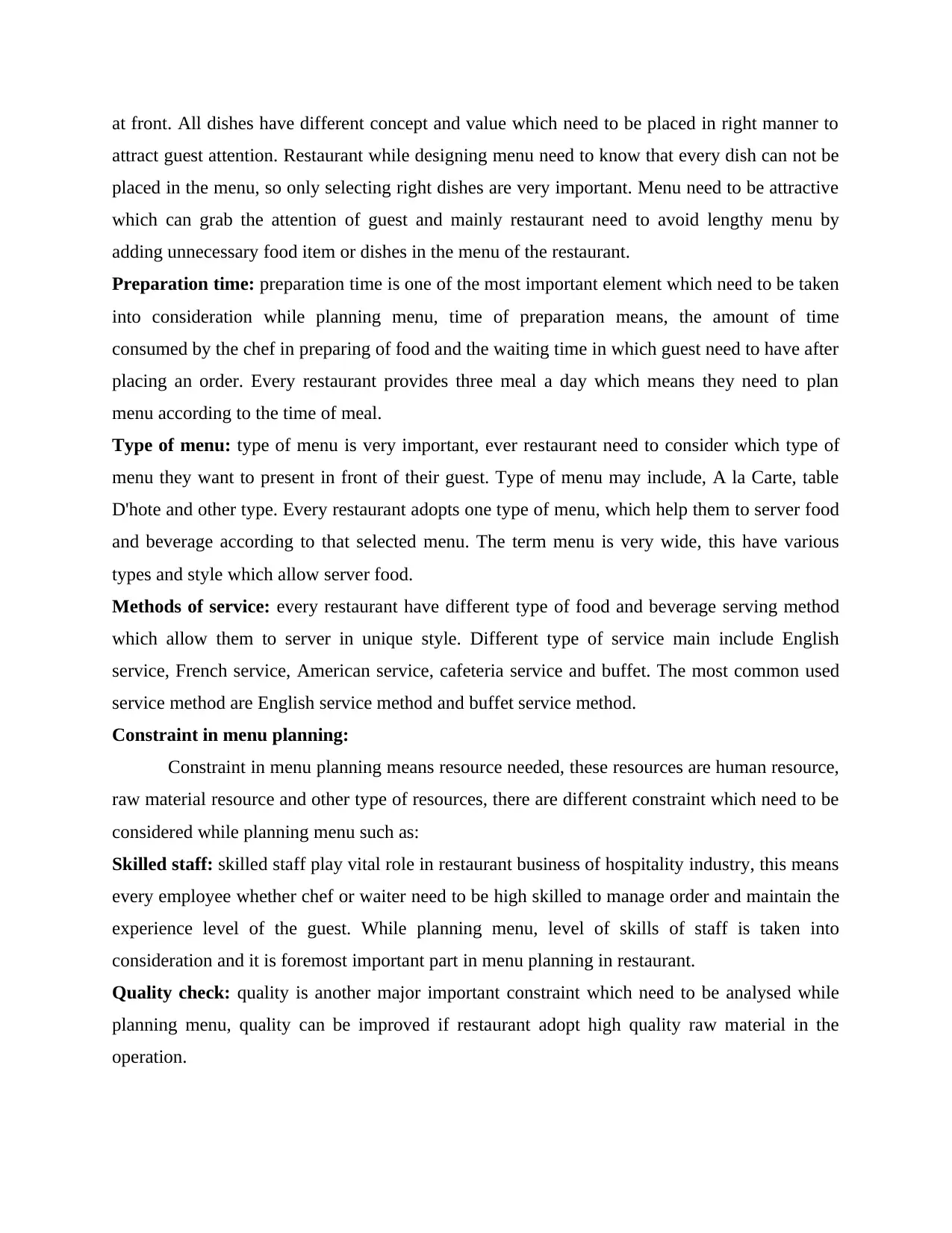
at front. All dishes have different concept and value which need to be placed in right manner to
attract guest attention. Restaurant while designing menu need to know that every dish can not be
placed in the menu, so only selecting right dishes are very important. Menu need to be attractive
which can grab the attention of guest and mainly restaurant need to avoid lengthy menu by
adding unnecessary food item or dishes in the menu of the restaurant.
Preparation time: preparation time is one of the most important element which need to be taken
into consideration while planning menu, time of preparation means, the amount of time
consumed by the chef in preparing of food and the waiting time in which guest need to have after
placing an order. Every restaurant provides three meal a day which means they need to plan
menu according to the time of meal.
Type of menu: type of menu is very important, ever restaurant need to consider which type of
menu they want to present in front of their guest. Type of menu may include, A la Carte, table
D'hote and other type. Every restaurant adopts one type of menu, which help them to server food
and beverage according to that selected menu. The term menu is very wide, this have various
types and style which allow server food.
Methods of service: every restaurant have different type of food and beverage serving method
which allow them to server in unique style. Different type of service main include English
service, French service, American service, cafeteria service and buffet. The most common used
service method are English service method and buffet service method.
Constraint in menu planning:
Constraint in menu planning means resource needed, these resources are human resource,
raw material resource and other type of resources, there are different constraint which need to be
considered while planning menu such as:
Skilled staff: skilled staff play vital role in restaurant business of hospitality industry, this means
every employee whether chef or waiter need to be high skilled to manage order and maintain the
experience level of the guest. While planning menu, level of skills of staff is taken into
consideration and it is foremost important part in menu planning in restaurant.
Quality check: quality is another major important constraint which need to be analysed while
planning menu, quality can be improved if restaurant adopt high quality raw material in the
operation.
attract guest attention. Restaurant while designing menu need to know that every dish can not be
placed in the menu, so only selecting right dishes are very important. Menu need to be attractive
which can grab the attention of guest and mainly restaurant need to avoid lengthy menu by
adding unnecessary food item or dishes in the menu of the restaurant.
Preparation time: preparation time is one of the most important element which need to be taken
into consideration while planning menu, time of preparation means, the amount of time
consumed by the chef in preparing of food and the waiting time in which guest need to have after
placing an order. Every restaurant provides three meal a day which means they need to plan
menu according to the time of meal.
Type of menu: type of menu is very important, ever restaurant need to consider which type of
menu they want to present in front of their guest. Type of menu may include, A la Carte, table
D'hote and other type. Every restaurant adopts one type of menu, which help them to server food
and beverage according to that selected menu. The term menu is very wide, this have various
types and style which allow server food.
Methods of service: every restaurant have different type of food and beverage serving method
which allow them to server in unique style. Different type of service main include English
service, French service, American service, cafeteria service and buffet. The most common used
service method are English service method and buffet service method.
Constraint in menu planning:
Constraint in menu planning means resource needed, these resources are human resource,
raw material resource and other type of resources, there are different constraint which need to be
considered while planning menu such as:
Skilled staff: skilled staff play vital role in restaurant business of hospitality industry, this means
every employee whether chef or waiter need to be high skilled to manage order and maintain the
experience level of the guest. While planning menu, level of skills of staff is taken into
consideration and it is foremost important part in menu planning in restaurant.
Quality check: quality is another major important constraint which need to be analysed while
planning menu, quality can be improved if restaurant adopt high quality raw material in the
operation.
Paraphrase This Document
Need a fresh take? Get an instant paraphrase of this document with our AI Paraphraser
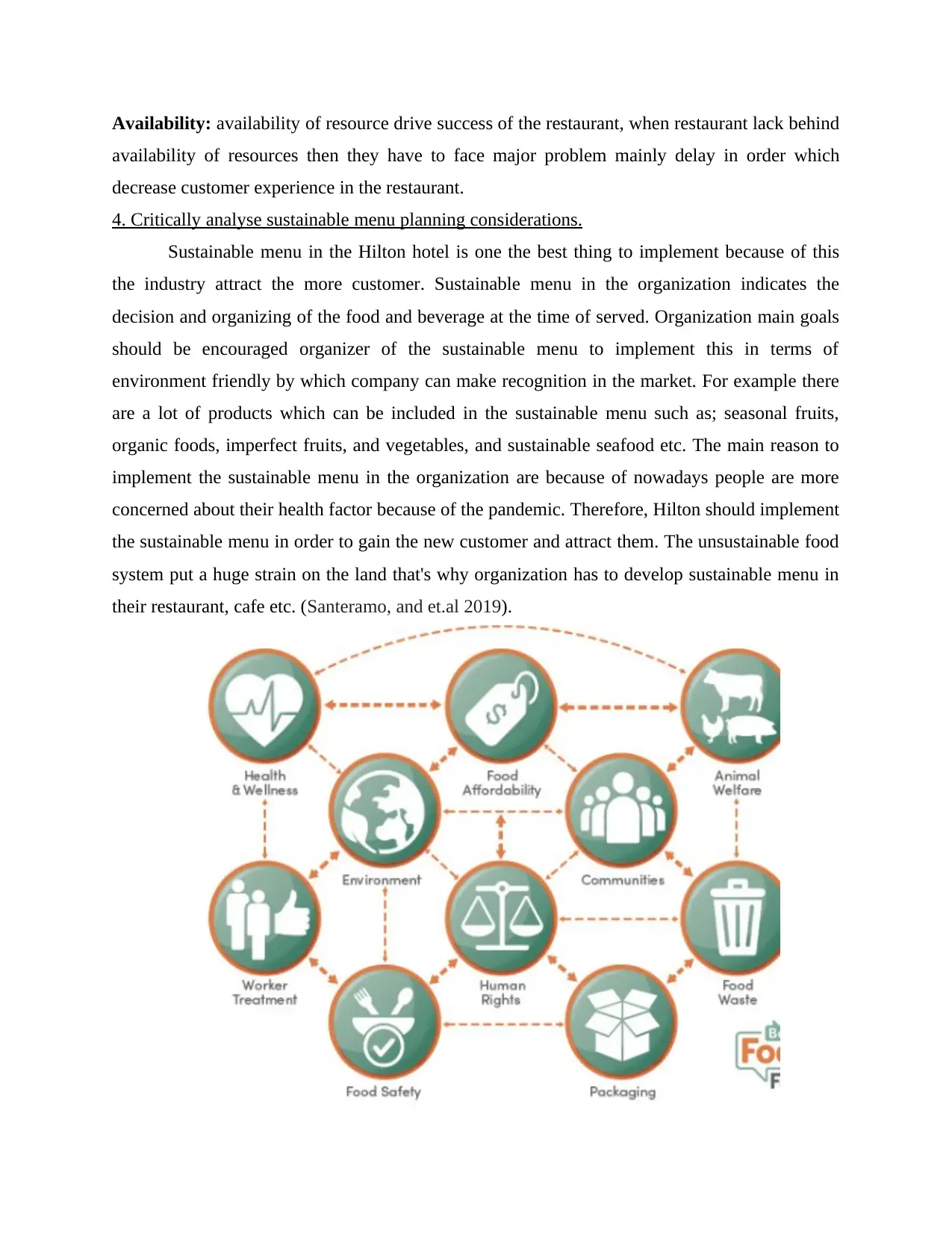
Availability: availability of resource drive success of the restaurant, when restaurant lack behind
availability of resources then they have to face major problem mainly delay in order which
decrease customer experience in the restaurant.
4. Critically analyse sustainable menu planning considerations.
Sustainable menu in the Hilton hotel is one the best thing to implement because of this
the industry attract the more customer. Sustainable menu in the organization indicates the
decision and organizing of the food and beverage at the time of served. Organization main goals
should be encouraged organizer of the sustainable menu to implement this in terms of
environment friendly by which company can make recognition in the market. For example there
are a lot of products which can be included in the sustainable menu such as; seasonal fruits,
organic foods, imperfect fruits, and vegetables, and sustainable seafood etc. The main reason to
implement the sustainable menu in the organization are because of nowadays people are more
concerned about their health factor because of the pandemic. Therefore, Hilton should implement
the sustainable menu in order to gain the new customer and attract them. The unsustainable food
system put a huge strain on the land that's why organization has to develop sustainable menu in
their restaurant, cafe etc. (Santeramo, and et.al 2019).
availability of resources then they have to face major problem mainly delay in order which
decrease customer experience in the restaurant.
4. Critically analyse sustainable menu planning considerations.
Sustainable menu in the Hilton hotel is one the best thing to implement because of this
the industry attract the more customer. Sustainable menu in the organization indicates the
decision and organizing of the food and beverage at the time of served. Organization main goals
should be encouraged organizer of the sustainable menu to implement this in terms of
environment friendly by which company can make recognition in the market. For example there
are a lot of products which can be included in the sustainable menu such as; seasonal fruits,
organic foods, imperfect fruits, and vegetables, and sustainable seafood etc. The main reason to
implement the sustainable menu in the organization are because of nowadays people are more
concerned about their health factor because of the pandemic. Therefore, Hilton should implement
the sustainable menu in order to gain the new customer and attract them. The unsustainable food
system put a huge strain on the land that's why organization has to develop sustainable menu in
their restaurant, cafe etc. (Santeramo, and et.al 2019).
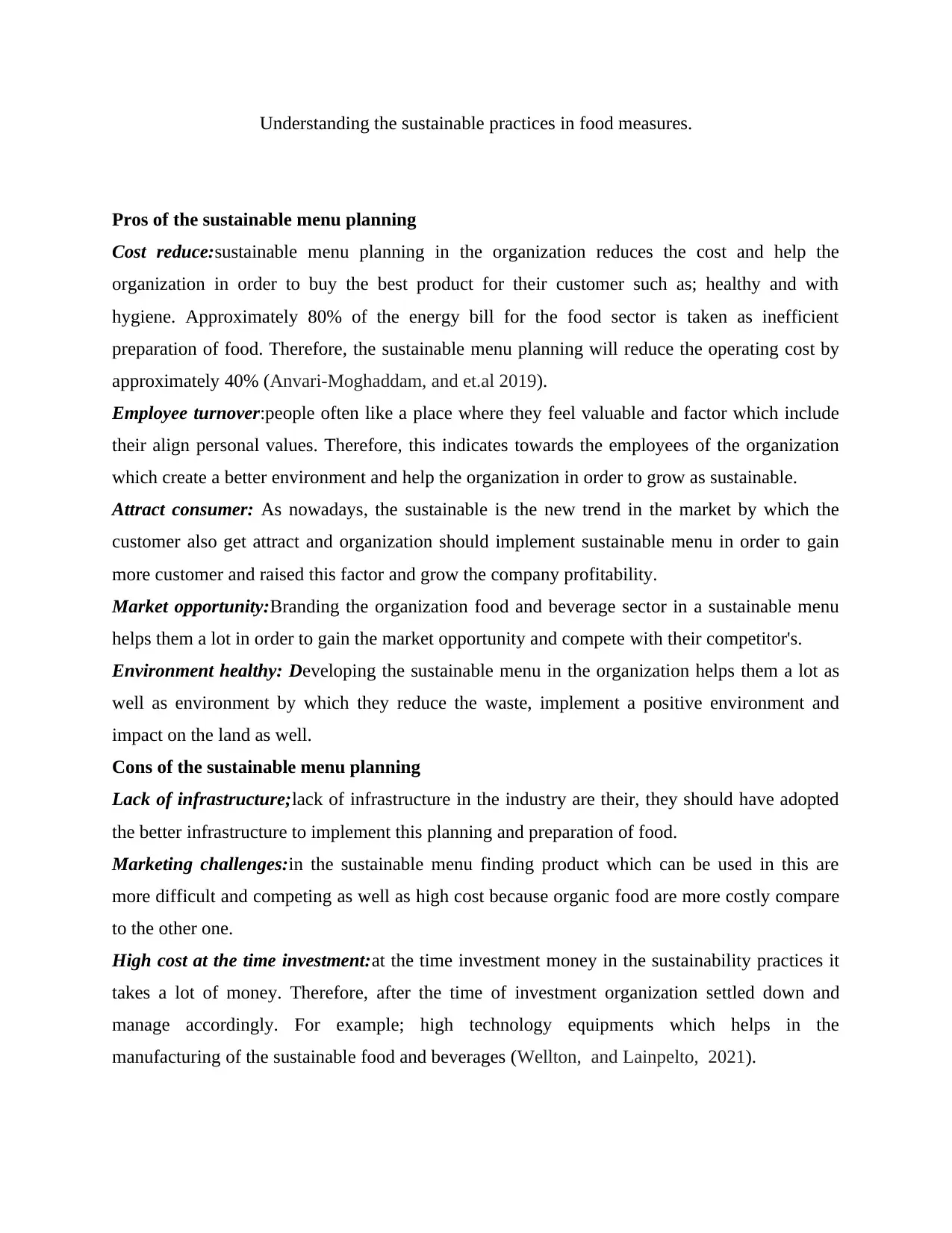
Understanding the sustainable practices in food measures.
Pros of the sustainable menu planning
Cost reduce:sustainable menu planning in the organization reduces the cost and help the
organization in order to buy the best product for their customer such as; healthy and with
hygiene. Approximately 80% of the energy bill for the food sector is taken as inefficient
preparation of food. Therefore, the sustainable menu planning will reduce the operating cost by
approximately 40% (Anvari-Moghaddam, and et.al 2019).
Employee turnover:people often like a place where they feel valuable and factor which include
their align personal values. Therefore, this indicates towards the employees of the organization
which create a better environment and help the organization in order to grow as sustainable.
Attract consumer: As nowadays, the sustainable is the new trend in the market by which the
customer also get attract and organization should implement sustainable menu in order to gain
more customer and raised this factor and grow the company profitability.
Market opportunity:Branding the organization food and beverage sector in a sustainable menu
helps them a lot in order to gain the market opportunity and compete with their competitor's.
Environment healthy: Developing the sustainable menu in the organization helps them a lot as
well as environment by which they reduce the waste, implement a positive environment and
impact on the land as well.
Cons of the sustainable menu planning
Lack of infrastructure;lack of infrastructure in the industry are their, they should have adopted
the better infrastructure to implement this planning and preparation of food.
Marketing challenges:in the sustainable menu finding product which can be used in this are
more difficult and competing as well as high cost because organic food are more costly compare
to the other one.
High cost at the time investment:at the time investment money in the sustainability practices it
takes a lot of money. Therefore, after the time of investment organization settled down and
manage accordingly. For example; high technology equipments which helps in the
manufacturing of the sustainable food and beverages (Wellton, and Lainpelto, 2021).
Pros of the sustainable menu planning
Cost reduce:sustainable menu planning in the organization reduces the cost and help the
organization in order to buy the best product for their customer such as; healthy and with
hygiene. Approximately 80% of the energy bill for the food sector is taken as inefficient
preparation of food. Therefore, the sustainable menu planning will reduce the operating cost by
approximately 40% (Anvari-Moghaddam, and et.al 2019).
Employee turnover:people often like a place where they feel valuable and factor which include
their align personal values. Therefore, this indicates towards the employees of the organization
which create a better environment and help the organization in order to grow as sustainable.
Attract consumer: As nowadays, the sustainable is the new trend in the market by which the
customer also get attract and organization should implement sustainable menu in order to gain
more customer and raised this factor and grow the company profitability.
Market opportunity:Branding the organization food and beverage sector in a sustainable menu
helps them a lot in order to gain the market opportunity and compete with their competitor's.
Environment healthy: Developing the sustainable menu in the organization helps them a lot as
well as environment by which they reduce the waste, implement a positive environment and
impact on the land as well.
Cons of the sustainable menu planning
Lack of infrastructure;lack of infrastructure in the industry are their, they should have adopted
the better infrastructure to implement this planning and preparation of food.
Marketing challenges:in the sustainable menu finding product which can be used in this are
more difficult and competing as well as high cost because organic food are more costly compare
to the other one.
High cost at the time investment:at the time investment money in the sustainability practices it
takes a lot of money. Therefore, after the time of investment organization settled down and
manage accordingly. For example; high technology equipments which helps in the
manufacturing of the sustainable food and beverages (Wellton, and Lainpelto, 2021).
⊘ This is a preview!⊘
Do you want full access?
Subscribe today to unlock all pages.

Trusted by 1+ million students worldwide
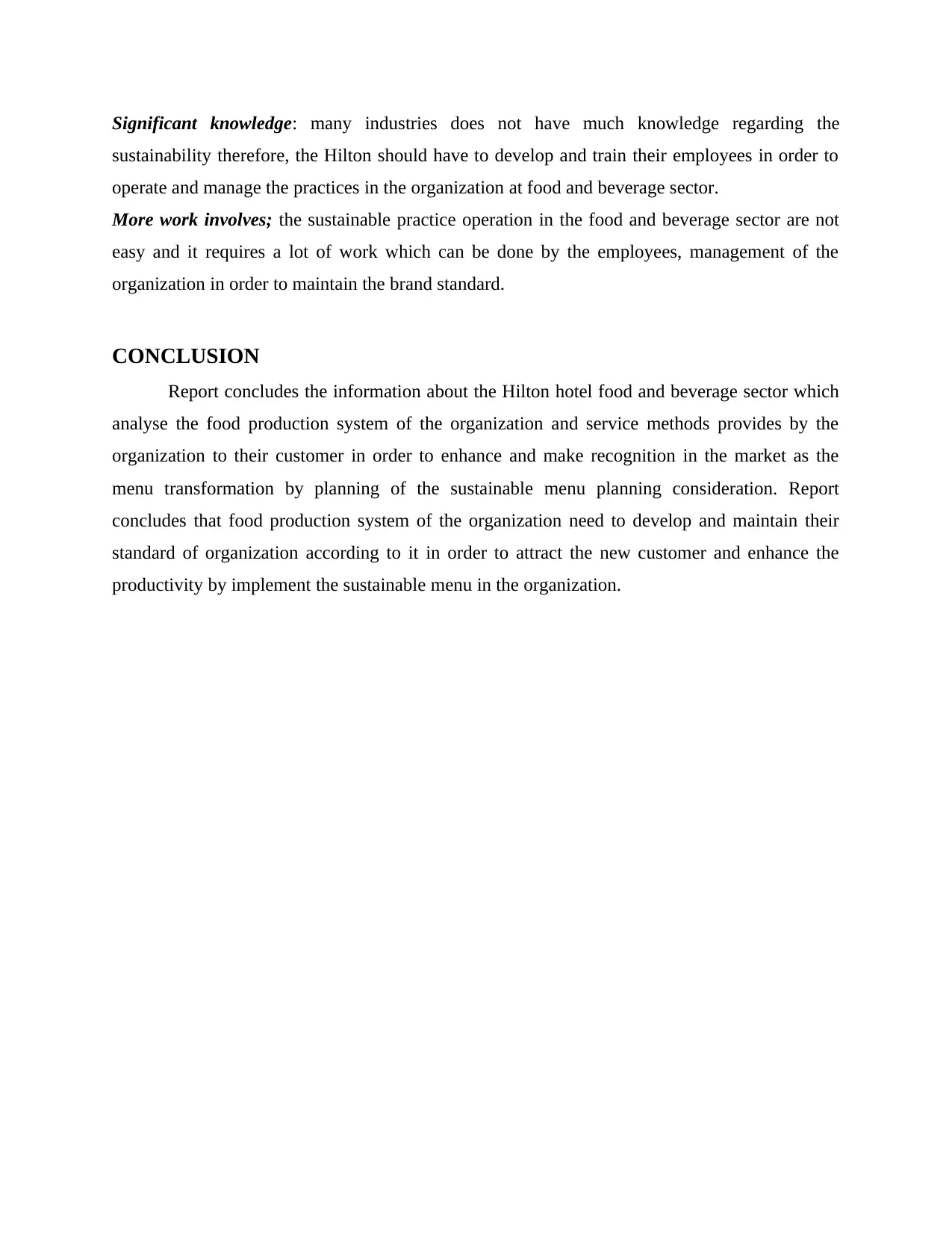
Significant knowledge: many industries does not have much knowledge regarding the
sustainability therefore, the Hilton should have to develop and train their employees in order to
operate and manage the practices in the organization at food and beverage sector.
More work involves; the sustainable practice operation in the food and beverage sector are not
easy and it requires a lot of work which can be done by the employees, management of the
organization in order to maintain the brand standard.
CONCLUSION
Report concludes the information about the Hilton hotel food and beverage sector which
analyse the food production system of the organization and service methods provides by the
organization to their customer in order to enhance and make recognition in the market as the
menu transformation by planning of the sustainable menu planning consideration. Report
concludes that food production system of the organization need to develop and maintain their
standard of organization according to it in order to attract the new customer and enhance the
productivity by implement the sustainable menu in the organization.
sustainability therefore, the Hilton should have to develop and train their employees in order to
operate and manage the practices in the organization at food and beverage sector.
More work involves; the sustainable practice operation in the food and beverage sector are not
easy and it requires a lot of work which can be done by the employees, management of the
organization in order to maintain the brand standard.
CONCLUSION
Report concludes the information about the Hilton hotel food and beverage sector which
analyse the food production system of the organization and service methods provides by the
organization to their customer in order to enhance and make recognition in the market as the
menu transformation by planning of the sustainable menu planning consideration. Report
concludes that food production system of the organization need to develop and maintain their
standard of organization according to it in order to attract the new customer and enhance the
productivity by implement the sustainable menu in the organization.
Paraphrase This Document
Need a fresh take? Get an instant paraphrase of this document with our AI Paraphraser
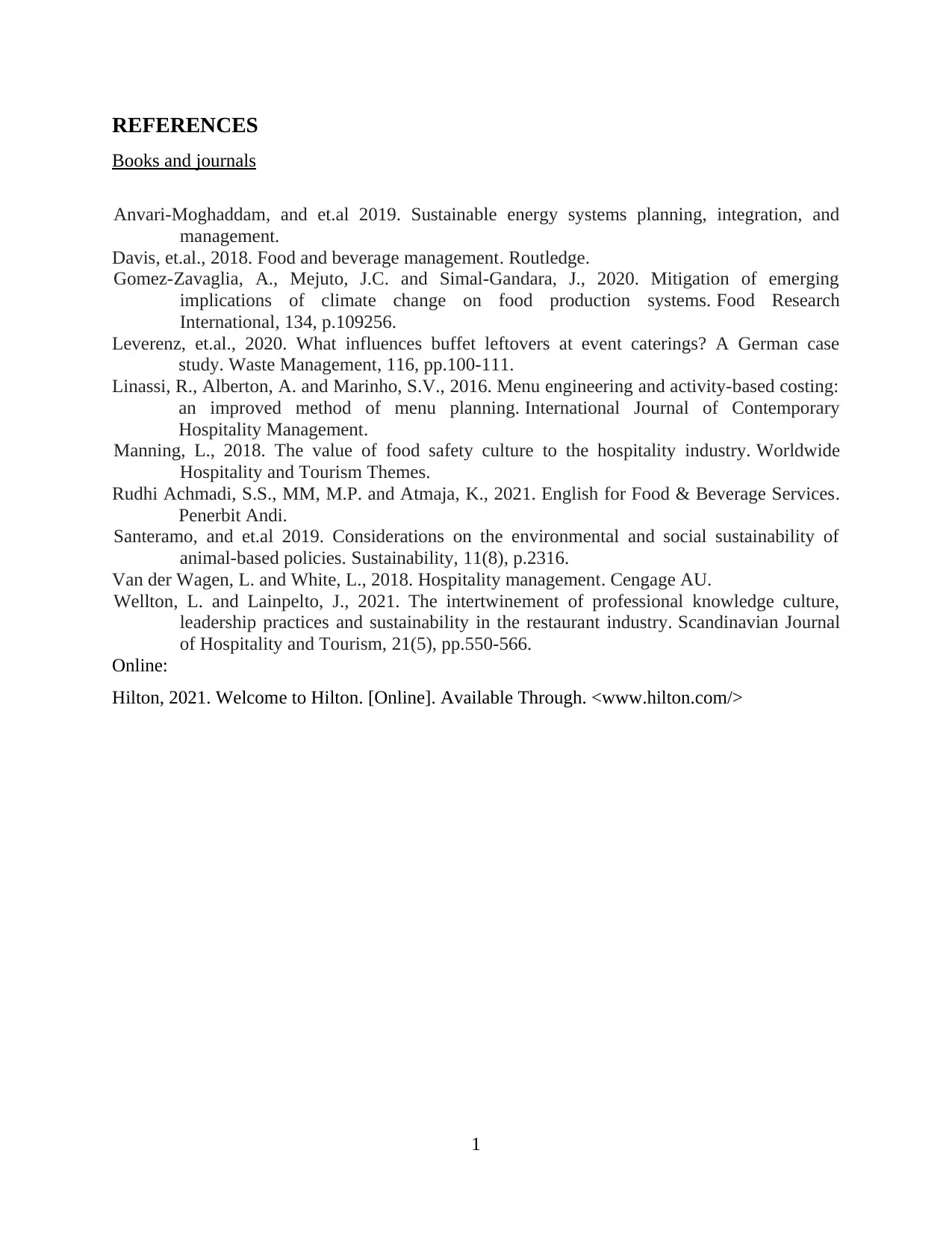
REFERENCES
Books and journals
Anvari-Moghaddam, and et.al 2019. Sustainable energy systems planning, integration, and
management.
Davis, et.al., 2018. Food and beverage management. Routledge.
Gomez-Zavaglia, A., Mejuto, J.C. and Simal-Gandara, J., 2020. Mitigation of emerging
implications of climate change on food production systems. Food Research
International, 134, p.109256.
Leverenz, et.al., 2020. What influences buffet leftovers at event caterings? A German case
study. Waste Management, 116, pp.100-111.
Linassi, R., Alberton, A. and Marinho, S.V., 2016. Menu engineering and activity-based costing:
an improved method of menu planning. International Journal of Contemporary
Hospitality Management.
Manning, L., 2018. The value of food safety culture to the hospitality industry. Worldwide
Hospitality and Tourism Themes.
Rudhi Achmadi, S.S., MM, M.P. and Atmaja, K., 2021. English for Food & Beverage Services.
Penerbit Andi.
Santeramo, and et.al 2019. Considerations on the environmental and social sustainability of
animal-based policies. Sustainability, 11(8), p.2316.
Van der Wagen, L. and White, L., 2018. Hospitality management. Cengage AU.
Wellton, L. and Lainpelto, J., 2021. The intertwinement of professional knowledge culture,
leadership practices and sustainability in the restaurant industry. Scandinavian Journal
of Hospitality and Tourism, 21(5), pp.550-566.
Online:
Hilton, 2021. Welcome to Hilton. [Online]. Available Through. <www.hilton.com/>
1
Books and journals
Anvari-Moghaddam, and et.al 2019. Sustainable energy systems planning, integration, and
management.
Davis, et.al., 2018. Food and beverage management. Routledge.
Gomez-Zavaglia, A., Mejuto, J.C. and Simal-Gandara, J., 2020. Mitigation of emerging
implications of climate change on food production systems. Food Research
International, 134, p.109256.
Leverenz, et.al., 2020. What influences buffet leftovers at event caterings? A German case
study. Waste Management, 116, pp.100-111.
Linassi, R., Alberton, A. and Marinho, S.V., 2016. Menu engineering and activity-based costing:
an improved method of menu planning. International Journal of Contemporary
Hospitality Management.
Manning, L., 2018. The value of food safety culture to the hospitality industry. Worldwide
Hospitality and Tourism Themes.
Rudhi Achmadi, S.S., MM, M.P. and Atmaja, K., 2021. English for Food & Beverage Services.
Penerbit Andi.
Santeramo, and et.al 2019. Considerations on the environmental and social sustainability of
animal-based policies. Sustainability, 11(8), p.2316.
Van der Wagen, L. and White, L., 2018. Hospitality management. Cengage AU.
Wellton, L. and Lainpelto, J., 2021. The intertwinement of professional knowledge culture,
leadership practices and sustainability in the restaurant industry. Scandinavian Journal
of Hospitality and Tourism, 21(5), pp.550-566.
Online:
Hilton, 2021. Welcome to Hilton. [Online]. Available Through. <www.hilton.com/>
1
1 out of 11
Related Documents
Your All-in-One AI-Powered Toolkit for Academic Success.
+13062052269
info@desklib.com
Available 24*7 on WhatsApp / Email
![[object Object]](/_next/static/media/star-bottom.7253800d.svg)
Unlock your academic potential
Copyright © 2020–2025 A2Z Services. All Rights Reserved. Developed and managed by ZUCOL.




